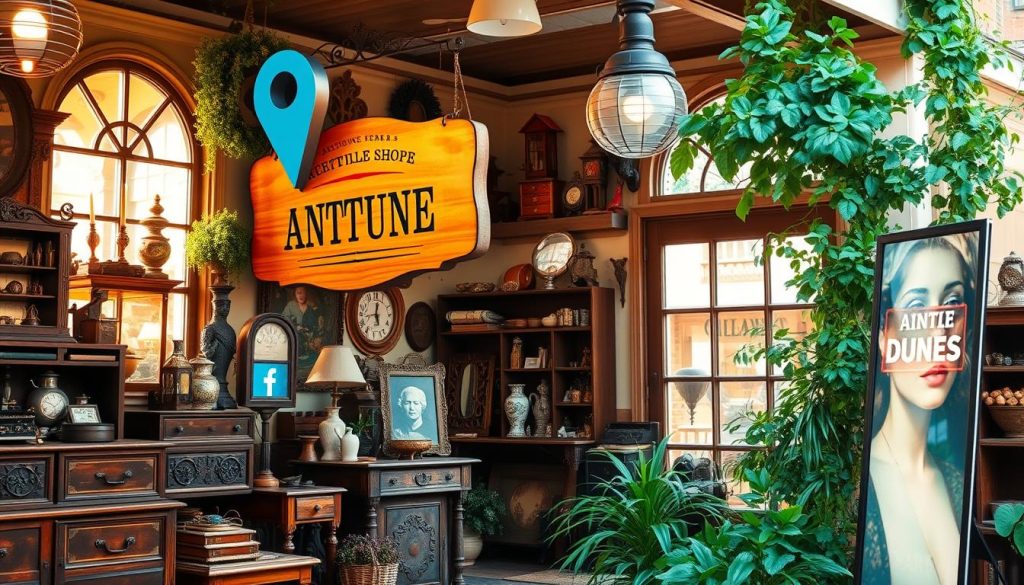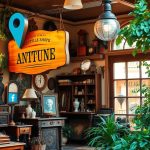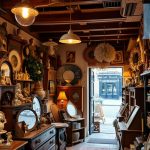In today’s digital world, making your antique business stand out is vital. Online marketing for antiques has become a must. By using modern marketing, antique sellers can make their items more appealing online. This article will share key strategies and tools to boost your online presence. We’ll start by looking at the antique market today.
Key Takeaways
- Understanding the online landscape is key for promoting antiques effectively.
- Enhancing customer engagement can boost your antique business visibility.
- Strategic marketing efforts are essential in the digital age.
- Effective use of online platforms can help reach discerning buyers.
- Distinguishing your antiques from other products is vital for success.
Understanding the Antique Market Landscape
The antique market is full of variety and life for both collectors and dealers. It includes furniture, collectibles, and vintage art, appealing to many tastes. Recently, there’s been a big move towards sustainability and heritage, changing what people want to buy.
Now, people are looking for unique and genuine items that have a story. This makes the age and history of an item very important. Dealers need to update their stock to meet these new tastes.
To do well, understanding the antique business is key. Things like changes in population, the economy, and how people shop online affect what buyers want. By keeping an eye on these trends, dealers can make marketing that speaks to their customers. This helps them succeed in a tough market.
The Importance of Online Presence
For antique businesses, having a strong online presence is crucial. It greatly affects how visible and engaging they are. Today, people often look online for unique antiques. Businesses with an online presence see more customer interaction and sales.
Having a good online presence is key to reaching more people. A well-designed website is like a virtual shop, showing off products and making the brand known. Without a strong online plan, antique sellers might miss out on customers. Not using online marketing means fewer customers and slower growth compared to competitors.
Online marketing has many benefits for antiques. It makes them more visible on the internet, drawing in buyers and encouraging them to come back. Using social media helps build a strong brand and a loyal customer base. This approach can make an antique business more successful and lasting in a tough market.
Creating a User-Friendly Website
Building a user-friendly website for antiques means focusing on design and functionality. It should draw in visitors and give them a smooth experience. This encourages them to explore and interact more. Here are some key elements for a great online presence.
Key Features for an Engaging Website
Adding important website features boosts user experience. Think about these elements:
- Intuitive Navigation: Easy menus help visitors find what they need easily.
- Visually Appealing Design: A good design grabs attention and keeps it.
- High-Quality Images: Clear images show off antiques’ unique features.
- Comprehensive Product Descriptions: Telling the story of each item makes it more appealing and informative.
Enhancing Mobile Responsiveness
Mobile shopping is becoming more popular. A mobile-friendly antique shop is essential. Making sure your website works well on different screens can really help. Key points for mobile friendliness include:
| Feature | Importance |
|---|---|
| Adaptability | Content fits various screens, making for a better user experience. |
| Speed | Quick-loading pages keep visitors interested and lower bounce rates. |
| Touch-Friendly Interfaces | Buttons and links should be easy to click on mobile. |
| Optimised Images | Images are compressed to be fast-loading without losing quality. |
Utilising SEO for Your Antique Business

Search Engine Optimisation (SEO) is key to making antique businesses more visible online. By using smart SEO strategies, antique shops can get more organic traffic. Knowing how to do search engine optimisation for antiques helps dealers stand out in a busy market.
Keyword research is a must for a good SEO plan. Antique shops need to find out what words their customers use to look for products. They should look for both general and specific keywords related to antiques. This makes sure the website matches what people are searching for.
On-page optimisation is also crucial for SEO in the antique business. It means making title tags, meta descriptions, and content rich in relevant keywords. Writing quality content that answers buyers’ questions helps with rankings and keeps users interested, which search engines like.
Backlinks are like votes of support from other websites, making a business more credible and authoritative. Working with respected blogs and platforms in the antique world can get you valuable backlinks. This not only helps with rankings but also brings more targeted traffic to your site.
Using tools like Google Analytics helps keep an eye on SEO performance. Antique businesses can see where their traffic comes from, how users behave, and how many sales they make. This info helps make better decisions for ongoing improvement. By looking at this data, dealers can adapt to what customers want better.
| SEO Strategy | Description | Benefits |
|---|---|---|
| Keyword Research | Identifying terms potential customers use | Increased relevance in search results |
| On-Page Optimisation | Optimising website elements for keywords | Improved user engagement and rankings |
| Backlink Building | Obtaining links from reputable sources | Enhanced credibility and referral traffic |
| Analytics Monitoring | Using tools to track website performance | Informed decision-making for strategy refinement |
Marketing and Promoting Your Antique Business
To succeed in the antique market, you need strong marketing strategies. It’s key to have a unique selling proposition (USP). This should show what makes your antiques special, drawing in potential customers.
A strong USP makes your brand stand out. It’s like a beacon in a crowded market.
Crafting a Unique Selling Proposition (USP)
Think about these points when making your USP:
- Authenticity: Talk about the history and background of your antiques.
- Customer Experience: Emphasise the special service or unique items you offer.
- Exclusivity: Highlight items that are hard to find elsewhere.
Using these ideas will help you stand out when promoting antiques.
Leveraging Social Media Platforms
Social media is great for antique shops. It lets you connect with customers and show off your items. Instagram and Facebook are perfect for sharing stories through pictures.
Here’s how to make the most of social media:
- Visual Content: Post high-quality images of your antiques to grab attention.
- Engagement: Talk to your followers with comments, polls, and stories.
- Targeted Campaigns: Use ads to reach people who love antiques.
Smart social media use can greatly increase your visibility. It helps you promote antiques and build a loyal customer base.
Content Marketing Strategies
Effective content marketing for antiques is key to drawing in potential customers and building strong relationships. By making engaging content antiques, businesses can show off their knowledge and give valuable info to their audience.
Writing a blog antique business is a great way to start. Focus on topics like how to care for antiques, restoration tips, and the history of different pieces. This makes the business seem like a go-to source and grabs the interest of readers who love antiques.
- Tell a story: Sharing the history behind unique antiques builds emotional connections with potential buyers.
- Create instructional content: Guide readers through the restoration and maintenance of antiques.
- Utilise visuals: Incorporate images and videos to enhance storytelling and keep audiences engaged.
- Market trends insights: Offer analysis of current trends to establish thought leadership in the antique sector.
Using these strategies, businesses can get more visible and appealing in a crowded market. They’ll draw in a committed audience interested in engaging content antiques.
Building an Email Marketing List
Having a strong email marketing list is key to keeping in touch with loyal customers. It lets businesses share the latest news, deals, and events with clients. This way, they build a community of active customers, which helps in keeping relationships strong over time.
Creating Compelling Newsletters
For antique businesses, making newsletters that grab attention is crucial. These can include:
- Highlighted new arrivals
- Feature stories about unique pieces
- Exclusive previews of upcoming events
- Special discounts and offers for subscribers
For the best results, personalising newsletters is key. Tailoring content to different groups within your audience boosts engagement. Here are some tips to make your newsletters better:
- Use customer names in subject lines and greetings.
- Segment your email list by purchase history or interests.
- Add visually appealing images to show off antiques.
- Include clear calls to action (CTAs) to encourage action.
By using these strategies, businesses can make newsletters that inform and motivate. This keeps the conversation going with customers, making your email marketing more effective.
| Type of Content | Engagement Level | Subscriber Reaction |
|---|---|---|
| New arrivals | High | Increased interest in purchases |
| Feature stories | Medium | Enhanced emotional connection |
| Event previews | High | Positive anticipation |
| Special discounts | Very High | Increased conversion rates |
Engaging with Online Antique Communities
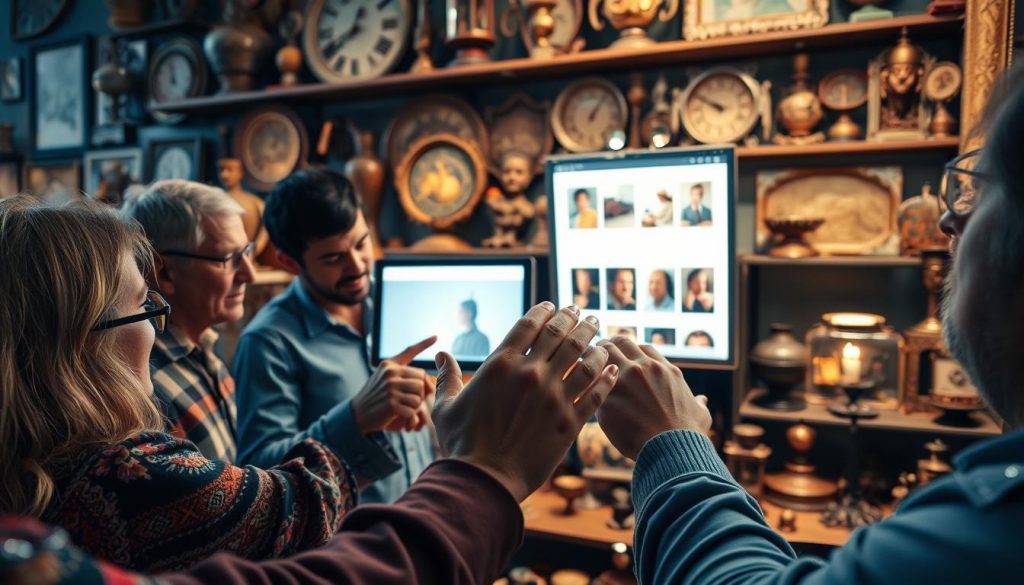
For antique businesses, online communities are a great way to network and make connections. These spaces, like forums, Facebook groups, and Reddit threads, bring together people who love antiques. By joining in, dealers can get noticed and build trust.
Being active means sharing your knowledge, answering questions, and sharing stories. This builds trust and makes your business a go-to place for antique info. It also helps you connect with collectors who value your expertise.
Here are some tips to get into these online groups:
- Regularly contribute valuable content.
- Respond promptly to questions and discussions.
- Share stories and experiences related to antiques.
- Collaborate with other members on community projects.
These steps help you network and build real connections with potential customers. Trust built through these interactions can lead to more visibility and loyalty for your business.
| Platform | Purpose | Best Practices |
|---|---|---|
| Forums | Exchange knowledge and discuss specific topics | Stay active, share experiences, and answer queries |
| Facebook Groups | Build community and engage in discussions | Post regularly, initiate conversations, and connect personally |
| Participate in niche-specific subreddits | Provide detailed insights and contribute to threads |
Using these platforms well can help your business stand out in online antique circles. This leads to great networking chances with collectors and enthusiasts.
Utilising Online Marketplaces for Visibility
In today’s digital world, selling antiques online means making smart choices about where to sell and how to list them. There are many online marketplaces for antiques, helping sellers find buyers who love unique items. Picking the best platform is key to getting noticed and making sales.
Choosing the Right Platforms
It’s important to look at who uses the online platforms you’re thinking about. Sites like eBay and Etsy have lots of users, but some antiques platforms might attract more serious buyers. Think about these things when picking a platform:
- Audience Reach: Check how big and what kind of customers the platform has.
- Specialisation: See if the platform is all about antiques or has a wider range of items.
- Fees: Look into the costs like listing fees, commissions, and how they handle payments.
- Usability: See how easy it is for both sellers and buyers to use the platform.
Optimising Your Listings
Being good at selling antiques online is all about making your listings stand out. Good listings grab attention and help you show up in searches. Here are some tips for making your antiques listings better:
- Keyword Usage: Put important keywords in your titles and descriptions to help people find you.
- High-Quality Images: Use clear, detailed pictures to show off your items from different angles.
- Detailed Descriptions: Give full descriptions, including size, material, and any history about the item.
- Competitive Pricing: Check out similar items to set prices that are good deals but still fair.
By choosing the right platforms and making your listings great, sellers can really boost their chances of success in the online antiques market.
Networking with Other Antique Dealers
Networking with antique dealers can really help your business grow. Working together can make you more visible and reach more customers. It’s key to share knowledge and resources with others in the industry.
Going to trade shows and local events is a great way to meet other dealers. These events create a supportive community. They help you deal with the challenges of the antique market. Online seminars are also good for networking antique dealers. They let you talk and share tips with others.
Having strong relationships can boost your reputation. Antique business partnerships let dealers work together on events and share marketing. This way, you can offer something special to customers. Networking means you can learn from others and make better business decisions.
| Activity | Benefits |
|---|---|
| Trade Shows | Face-to-face networking, visibility to potential buyers, trend spotting |
| Local Events | Community engagement, direct contact with customers, collaboration opportunities |
| Online Seminars | Knowledge sharing, leveraging digital tools, networking beyond geographical boundaries |
Connecting with other dealers and working together helps you overcome market challenges. Supporting each other builds a strong network. This network helps everyone involved to succeed and grow. So, networking is not just good to do; it’s crucial for your business’s future in antiques.
Utilising Paid Advertising Effectively
Paid advertising is a great way for antique businesses to get noticed. By using paid ads, shops can quickly find new customers. This saves a lot of time compared to just waiting for people to find them.
Using online ads like Google Ads and social media can really help. These ads let businesses set budgets, pick who they want to reach, and send out messages that grab attention. This is especially useful for reaching people interested in antiques.
Retargeting ads are very effective too. They focus on people who have shown interest in a business before. Knowing what customers like helps improve ads, making sure money is well spent and getting the best results.
It’s important to have clear budgets for ads. This keeps spending in check and helps see how well each ad is doing. Looking at things like how many people click on ads and how many buy something gives clues on what works best.
Here’s a closer look at some top paid advertising options for antique shops:
| Ad Type | Description | Advantages | Recommended Platforms |
|---|---|---|---|
| Google Ads | Search engine advertising targeting specific keywords related to antiques. | High visibility, immediate results, targeted traffic. | |
| Facebook Ads | Social media advertising with detailed targeting options. | Large audience, visual advertisements, multiple formats. | Facebook, Instagram |
| Retargeting Ads | Ads shown to users who visited your site but didn’t convert. | Higher conversion rates, cost-effective. | Google Display Network, Facebook |
| Display Ads | Banners shown on websites within relevant networks. | Visual impact, broad reach. | Google Display Network, various websites |
Good management and tracking can really boost the success of antique business ads. This leads to more sales and more customers getting involved.
Monitoring and Analysing Your Online Traffic
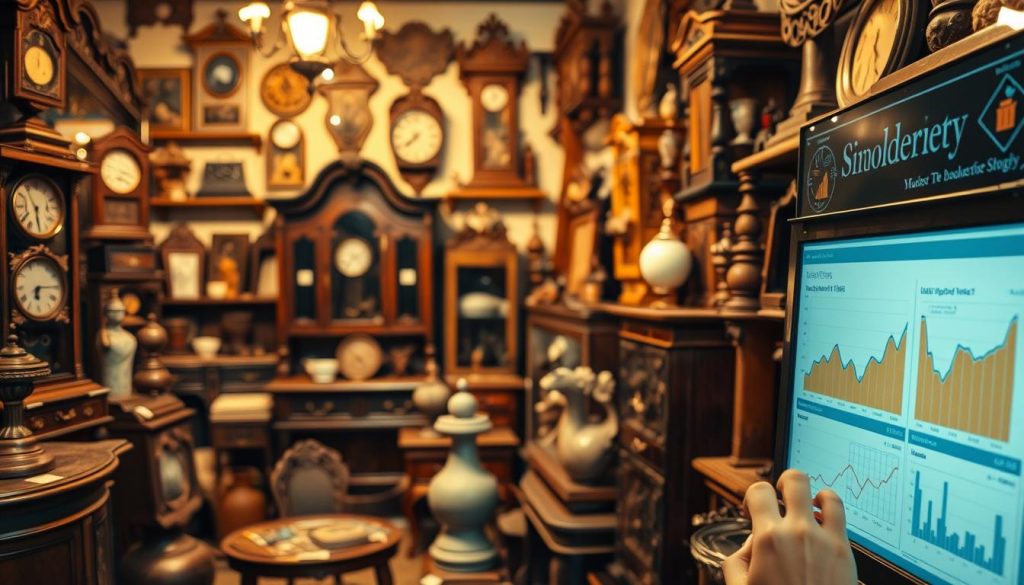
It’s vital to understand how visitors interact with your antique business. By keeping an eye on traffic, you can see how well your online presence connects with potential customers. This helps you make better strategies to stay ahead in the market.
Utilising Analytical Tools
Using analytics tools is key for deep insights. Tools like Google Analytics and social media insights give you important data. This data lets you see how visitors behave, how engaged they are, and how often they turn into customers.
These tools help track important things like:
- Website traffic sources
- Visitor demographics
- Average session duration
- Page views per session
- Bounce rate
Looking at this data helps you make smart choices based on what users do. Checking these points often lets you improve your site and marketing. Analytics tools for antiques make your work easier and help you reach your business goals.
Staying Current with Antique Trends
It’s crucial for antique dealers to keep up with the latest trends. Knowing what’s in style for 2023 can help with inventory, marketing, and connecting with customers.
Researching Market Changes
Good market research is key to understanding what buyers want. Here are some tips:
- Attend trade fairs and exhibitions to see what’s new and popular.
- Subscribe to antique magazines for expert views and market updates.
- Join online forums where collectors share their thoughts and trends.
Using these approaches helps tailor your business to what customers want.
| Research Method | Description | Benefits |
|---|---|---|
| Trade Fairs | Events showcasing various antiques and providing networking opportunities. | Insight into popular styles and direct engagement with potential customers. |
| Antique Magazines | Publications dedicated to the antique market featuring articles and advertisements. | Access to expert opinions and trending items. |
| Online Communities | Forums and social media groups focused on antiques and collectibles. | Real-time discussions on trends and customer preferences. |
By following these steps, you’ll get a clearer picture of the antique market. This will make your business more flexible and responsive to customer tastes.
Offering Exceptional Customer Service Online
In the antique sector, great customer service is key to success. Customers like quick and personal help, which builds trust in your brand. Good online support for antiques can make customers come back and buy more.
Here are some ways to make your online service better and keep customers happy:
- Answer quickly to show customers they matter.
- Have a clear return policy to make buyers feel secure.
- Have personal chats to make a strong bond with customers.
- Use customer feedback to make your service better.
Thinking carefully about how you serve customers helps solve problems and builds a good name in the antique world. Using these tips can make your antique shop stand out in a crowded market.
Utilising Visual Content for Promotion
Visual content is key in promoting antiques. It needs high-quality images that grab potential buyers’ attention. Good visuals show off the item’s details and create a bond with collectors and fans. Formats like:
- High-resolution photographs showcasing the item from multiple angles.
- Videos that offer a closer look at the craftsmanship and historical significance.
- Infographics that inform viewers about the piece’s background or provenance.
Here are some tips for making great content:
- Invest in professional photography for clear, detailed images.
- Use natural light to make antiques look their best.
- Add stories to your visuals to pull in potential customers.
Use platforms like Instagram and Pinterest for your visuals. These sites love visual content. Make sure your images fit their style to get more engagement. Good visual marketing helps your antique business shine online.
| Visual Content Type | Benefits | Best Practices |
|---|---|---|
| Photographs | Highlight intricate details, attract attention | Use high resolution, showcase from multiple angles |
| Videos | Demonstrate item usage, create emotional engagement | Keep it short, highlight key features and history |
| Infographics | Educate customers, provide context | Be concise, use compelling design |
Using visual content smartly makes your antique business stand out. It draws in customers and keeps their interest.
Encouraging Customer Reviews and Testimonials
In the antique business, customer reviews and testimonials are key to making potential clients choose you. To make the most of these, it’s vital to have good strategies for getting feedback after a sale. Sending follow-up emails to ask happy customers to share their stories is a good start.
You could also offer small discounts or loyalty points for feedback, getting more people to share their thoughts. This makes customers feel valued and more likely to give their opinions.
Showing off good reviews on your website and social media can really boost your trustworthiness. It makes potential buyers feel more secure about their purchase. Also, handling negative reviews well shows you care about customer satisfaction. This can turn a bad situation into a chance to show your brand’s true value.
Building trust through reviews means being open and honest with your customers. By asking for reviews and responding well, you improve your online image. You also build a community of loyal customers who feel important and heard. As you get more testimonials, you’ll attract more customers in the competitive antique market.

